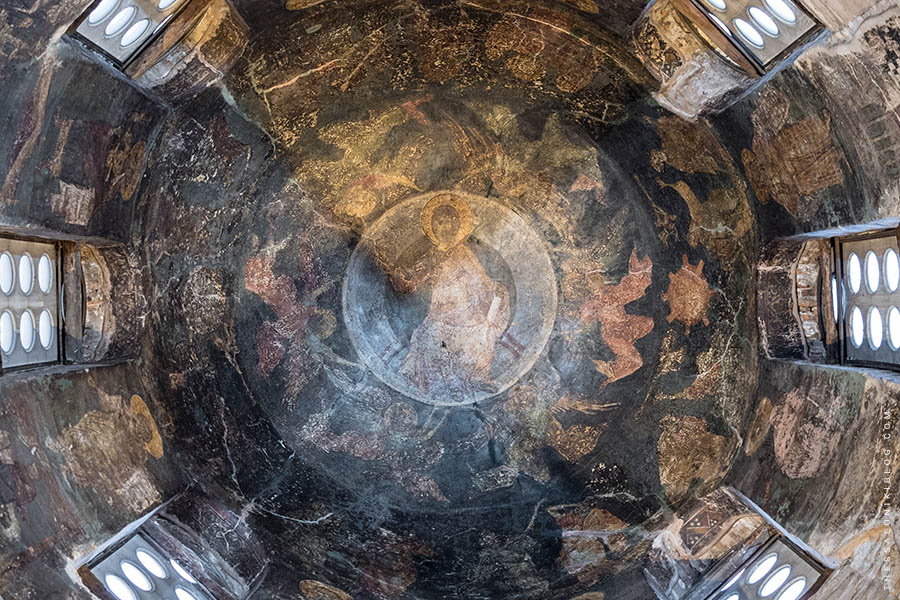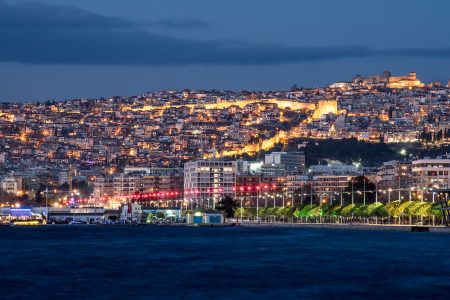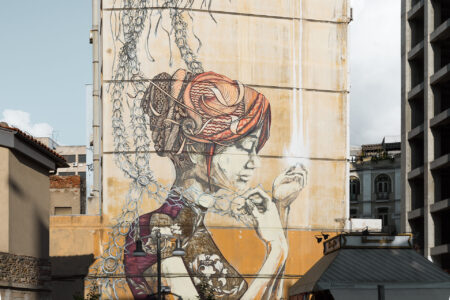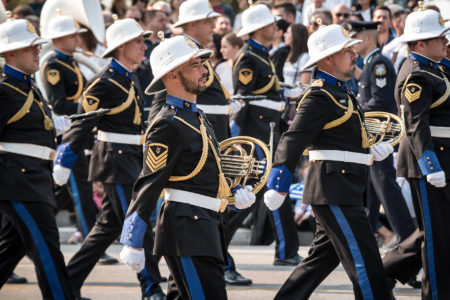VISITING THE UNESCO MONUMENTS OF THESSALONIKI
A Two-day Itinerary to the Paleochristian & Byzantine World Heritage Monuments of the City (Day 1)
The Byzantine period of Thessaloniki is the most extensive period of the city and also the most representative of its historical cultural identity. The architectural and artistic creations of the Byzantine years, together with earlier works of Paleochristian art, form a unique whole of great value that in 1988 was inscribed in the World Heritage List of UNESCO (“The Paleochristian and Byzantine Monuments of Thessalonika”, Ref: 456). Among the fifteen (15) listed monuments, there are many churches (along with their brilliant mosaics and wall-paintings), the only preserved Byzantine bath of the city, and the 4km-long defensive walls and fortifications.
All of the UNESCO monuments of Thessaloniki – located in several areas within the city walls – have been created between the 4th and the 15th century AD, a period during which Thessaloniki became the second most important commercial, artistic, and religious center of the Byzantine Empire after Constantinople.
In this article, you will find all the basic information about seven (7) of the UNESCO monuments of Thessaloniki that are included on day 1 of a recommended itinerary that is divided and scheduled in two (2) days (the minimum time needed to visit all 15 of them, especially if you want to explore their interior). You will also find many pictures and a map that will help you to easily navigate from one to another. All seven monuments of day 1 are located in the heart of the historical center within a short distance from one another and a total walking distance of about 2.6km (see “Route A” on the map, represented with the orange line).
Be aware that on certain days you could find some of the monuments closed. The Crypt of Agios Dimitrios and the Rotunda are closed on Tuesdays, while the Church of the Savior is closed on Sundays. If possible, avoid these days or visit these monuments separately on a different day (you can find all opening hours here).
You can read about the rest eight (8) of the UNESCO Monuments of Thessaloniki in the second part of the article (Day 2) here.
ITINERARY MAP
Map use instructions:
Along the orange line of the map, you can see the UNESCO monuments of Thessaloniki that are included on Day 1 (“Route A”) of the itinerary. The white line represents the city walls. Click on any pin to see the name of the monument that is located on that certain spot.
For a more detailed background image, click the “Satellite” button. For better navigation in mobile phones, tap on the square button on the top right corner to get into Full-Screen mode. To get into Street View mode, use the square button on the bottom right corner (drag and drop).
You can read about the monuments of the second day of the itinerary (the blue line) here.
1) CHURCH OF AGIOS DIMITRIOS (SAINT DEMETRIUS)
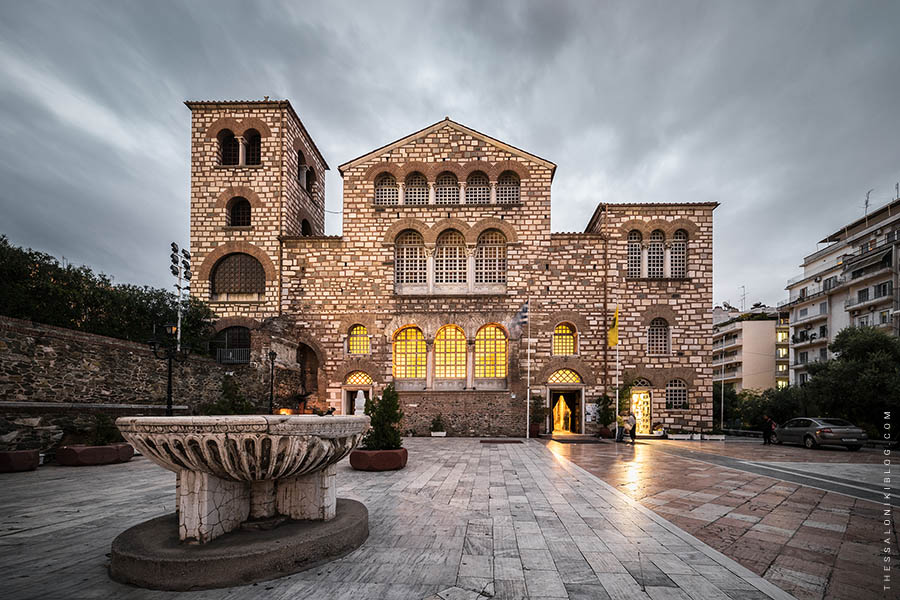
Address: 83 Agiou Dimitriou Street (see on Google Maps)
Church opening hours: Daily 07:00-21:00
Crypt opening hours:
Mondays, Wednesdays & Thursdays: 08:00-15:00
Fridays: 09:00-13:30 and 19:00-22:00 (church Service)
Weekends: 07:30-14:30
On Tuesdays, the crypt is closed
Admission: Free entrance (Church and Crypt)
Phone number: +30 231 027 0008
Address:
83 Agiou Dimitriou Street (see on Google Maps)
Church opening hours:
Daily 07:00-21:00
Crypt opening hours:
Mondays, Wednesdays & Thursdays: 08:00-15:00
Fridays: 09:00-13:30 and 19:00-22:00 (church Service)
Weekends: 07:30-14:30
On Tuesdays the crypt is closed
Admission:
Free entrance (Church and Crypt)
Phone number:
+30 231 027 0008
- 83 Agiou Dimitriou Street
- +30 231 027 0008
- See on Google Maps
- Free entrance (Church and Crypt)
- Daily: 07:00-21:00 (Church only)
Crypt opening hours:
Mondays, Wednesdays & Thursdays: 08:00-15:00
Fridays: 09:00-13:30 and 19:00-22:00 (church Service)
Weekends: 07:30-14:30
On Tuesdays the crypt is closed
The church of Agios Dimitrios is a Byzantine five-aisled basilica, that was built in the first half of the 7th century AD. It is the third and the largest temple that was erected on the same site, following an earlier Paleochristian three-aisled basilica of the 5th century that was destroyed by fire, and a small oratory of the 4th century. Many of the architectural elements and mosaics of the previous basilica were incorporated into the final church. Earlier on the site, there was a Roman bath where, according to Christian tradition and hagiology, Demetrius of Thessaloniki became a martyr during the Diocletian Persecution (some scholars are identifying him with Demetrius of Sirmium). For centuries, Thessaloniki and the church of Agios Dimitrios were the centers of his worship and every October the Dimitria religious festival was taking place in his honor. The festival was revived in 1962 and it still takes place in the form of several cultural events throughout the entire month. For the Christians of Thessaloniki, Saint Demetrius was and still is the patron Saint and protector of the city (he is officially celebrated on October 26).
Following the Ottoman conquest of Thessaloniki, and like most of the city’s Byzantine churches, the basilica of Agios Dimitrios was converted into a mosque at the end of the 15th century. It was restored back into a Christian church after the Greeks took back the city from the Ottomans on October 26, 1912 (on the feast day of Saint Demetrius). In the Great Fire of Thessaloniki, in 1917, the monument was severely damaged. The wooden roof, the upper walls, the galleries and many of its mosaics and wall-paintings, were destroyed. The restoration process lasted for decades and the church did not function again until 1949. The crypt and the ruins of the Roman bath on which the church was built, were discovered during the archaeological excavations that were held at that time (during the Ottoman Period the crypt was filled with earth). Inside the crypt, there is a fountain that was used as a source of holy water and a small church left of the entrance (the latter is assumed that it is the 4th-century oratory which was built at the same place where Saint Demetrius was killed). Today, the crypt hosts a permanent exhibition with findings that were discovered on site. It is accessed by stairs that are located inside the church, close to the south column of the chancel.
The mosaics that survived through the fire of 1917 are dated between the 5th and the 9th century and are considered fine examples of Paleochristian and Byzantine Art. They are located on the two columns, left and right of the chancel, and on the walls above the left and the right openings between the narthex and the nave. Only a few wall-paintings have been saved, mostly at the south aisle and the narthex. The beautiful ornate marble capitals of the columns (at the aisles, the galleries, the narthex tribelon, and the windows) probably belonged to the earlier three-aisled basilica, or to other, even older, Roman or Christian buildings. They were reused in the 7th-century basilica and again during its restoration following the fire of 1917.
At the west of the outer north aisle, there is a remaining part of the old Roman bath that has been incorporated into the temple as an internal chapel containing the cenotaph of Saint Demetrius. This was the only place where the Christians could worship their Saint after the church was converted into a mosque. In the south-east corner of the temple, there is also the chapel of Saint Euthymius that was built in the 13th century. The latter contains wall-paintings of the early 14th century, that belong to the art of the Paleologan Period. In the midst of the outer north aisle of the basilica, there are the relics of Saint Demetrius, kept inside a marble ciborium. Every day, hundreds of pilgrims visit the church just to worship the relics of their Saint.
How to get there:
The church of Agios Dimitrios is the starting point of the first day of our recommended itinerary (Route A). It is located on number 83 of the namesake street, along the axis of Aristotelous Square, north of the archaeological site of the Roman Agora. You can easily reach the location on foot, given that you are in the center of the city, or by taking bus 23 (“Agiou Dimitriou” bus-stop).
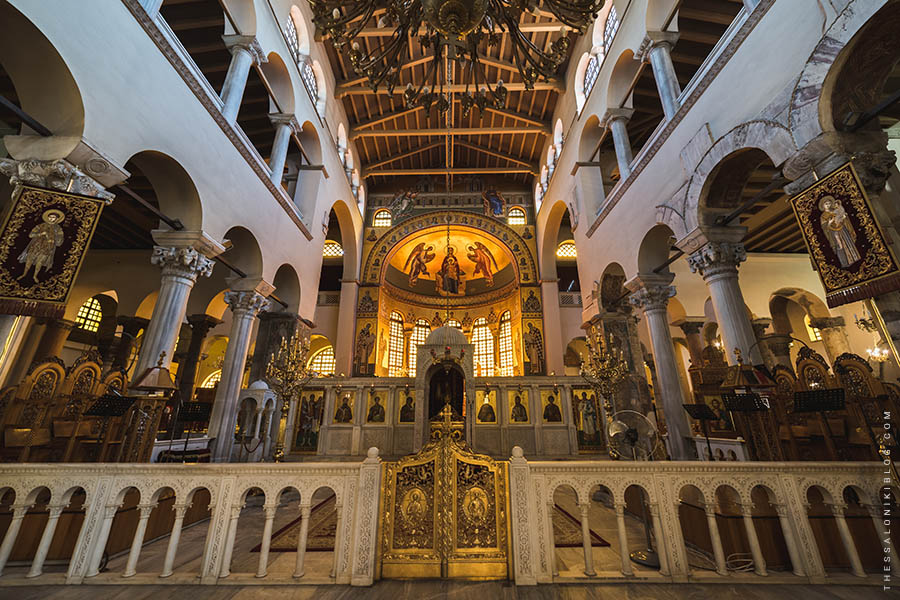
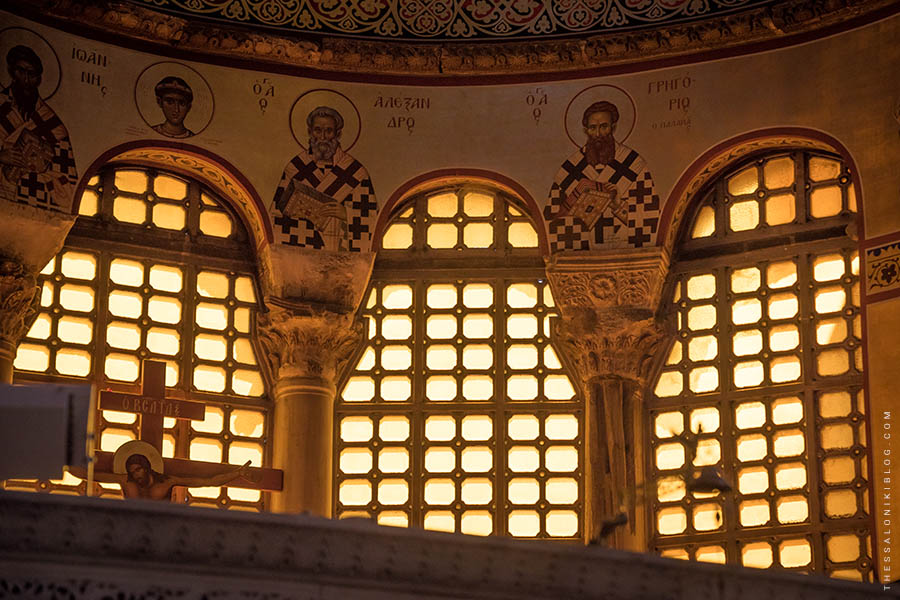
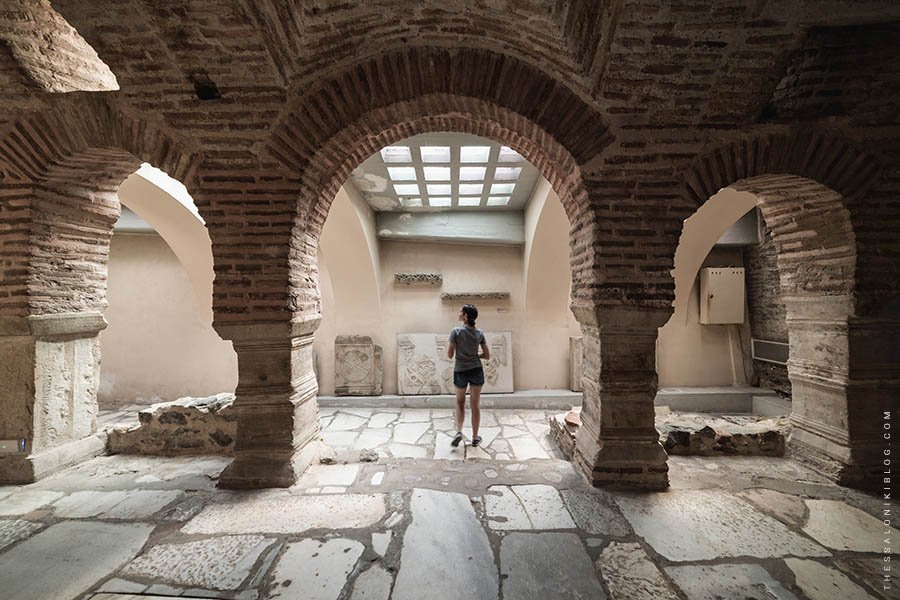
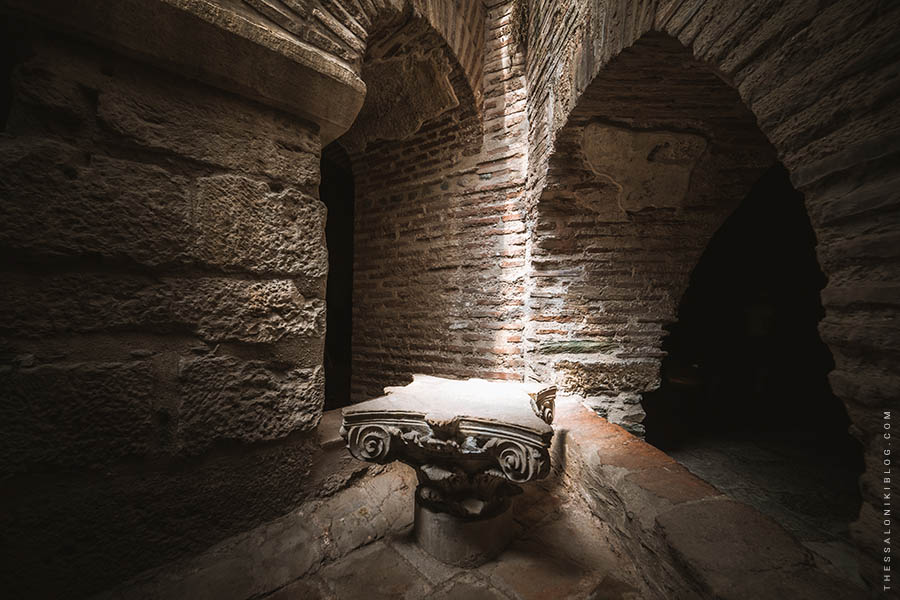
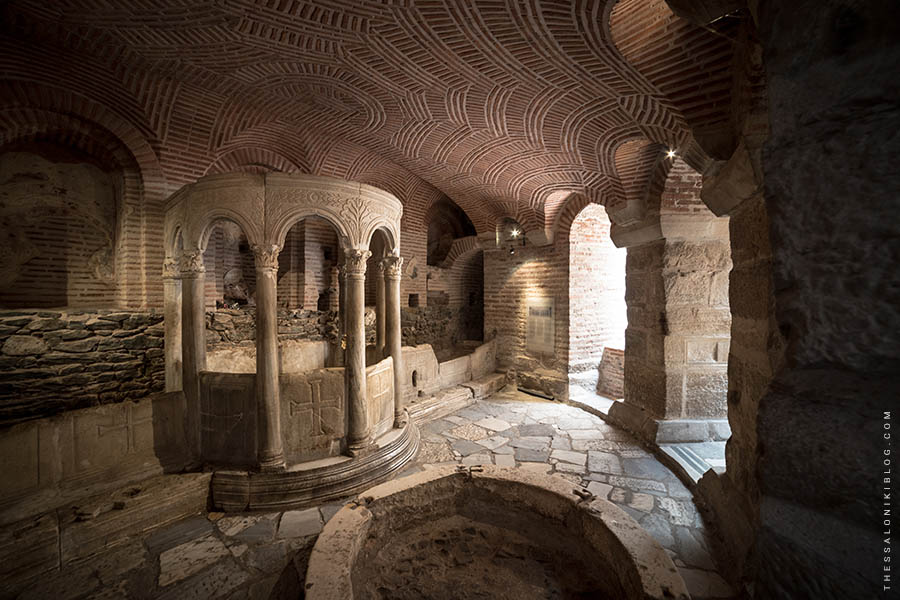
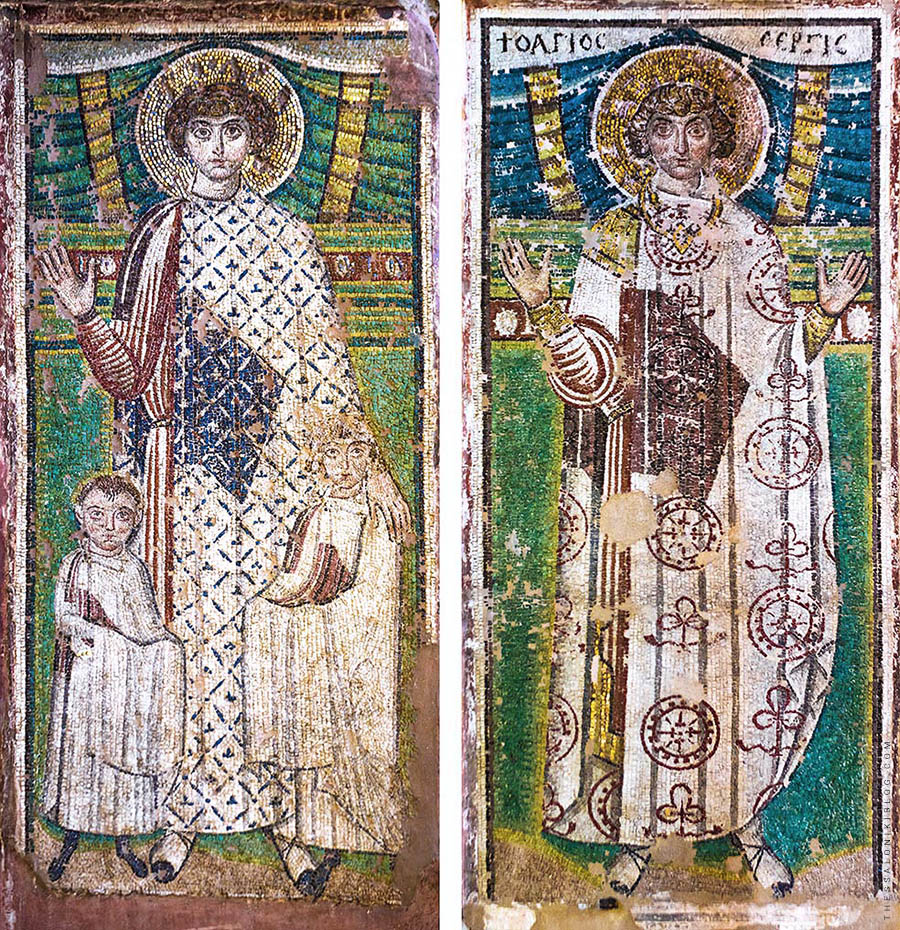
2) PANAGIA CHALKEON
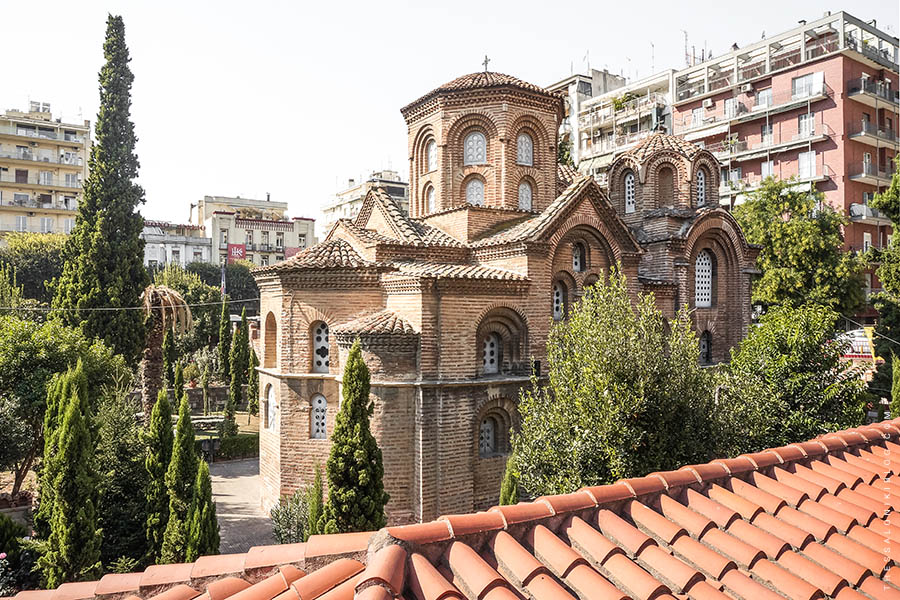
Address: Junction of Egnatias and Chalkeon Streets on Aristotelous Square (see on Google Maps)
Opening hours: Daily 07:30-12:00 (11:00 on Saturdays) and during the Vespers in the evening
Admission: Free entrance
Phone number: +30 231 027 2910
Address:
Junction of Egnatias and Chalkeon Streets on Aristotelous Square (see on Google Maps)
Opening hours:
Daily 07:30-12:00 (11:00 on Saturdays) and during the Vespers in the evening
Admission:
Free entrance
Phone number:
+30 231 027 2910
Panagia Chalkeon is a Byzantine cross-in-square church, dedicated to Virgin Mary. According to the founder’s inscription on the marble lintel over the West entrance, it was built on 1028 AD, during the period that the Byzantine Empire was ruled by the Macedonian Dynasty. In the midst of the North wall, there is a tomb that possibly belongs to the church’s founder, a Byzantine official with the name Christoforos.
The name “Chalkeon” (from the Greek word “chalkos”=copper) derives from the location of the temple, which was the area of the coppersmiths’ workshops during the Byzantine years. It is speculated that its original name was probably Panagia Chalkoprateion, like the church with the same name in Constantinople. It was also called the “Red Church” since it is constructed almost entirely with bricks.
The architecture of Panagia Chalkeon and its wall-paintings were influenced by the churches of the Byzantine capital. Τhe exterior of the temple is formed with several arches, brick patterns, a marble cornice around the building, and three domes (the main dome at the center and two smaller ones over the narthex), that all together give the quite elegant and elaborate appearance of the church. Its marble decoration consists of the narthex’s lintels and of the four ornate capitals on the columns of the nave that support the main dome. The wall-paintings that have been saved are dated from the time that the church was built. Some parts of them in the nave, however, have been replaced during the Palaeologan Era (14th century).
The church was converted into a mosque with the name Kazancilar Camii (Coppersmith’s Mosque) in 1430 and remained a mosque until 1912. The building itself and its wall-paintings have undergone restoration work in the 20th century after they were damaged by earthquakes.
How to get there:
From the church of Agios Dimitrios, walk south-west, along the axis of Aristotelous Square. Just before you reach Egnatias Street turn right and walk towards Chalkeon Street where you will find the entrance to the church’s courtyard. The total walking distance is approximately 600m. Independently of our recommended itinerary, you can get there easily by foot, from the center of the city, or by any of the several buses that pass from the adjacent “Alcazar” bus stop on Egnatias Street.
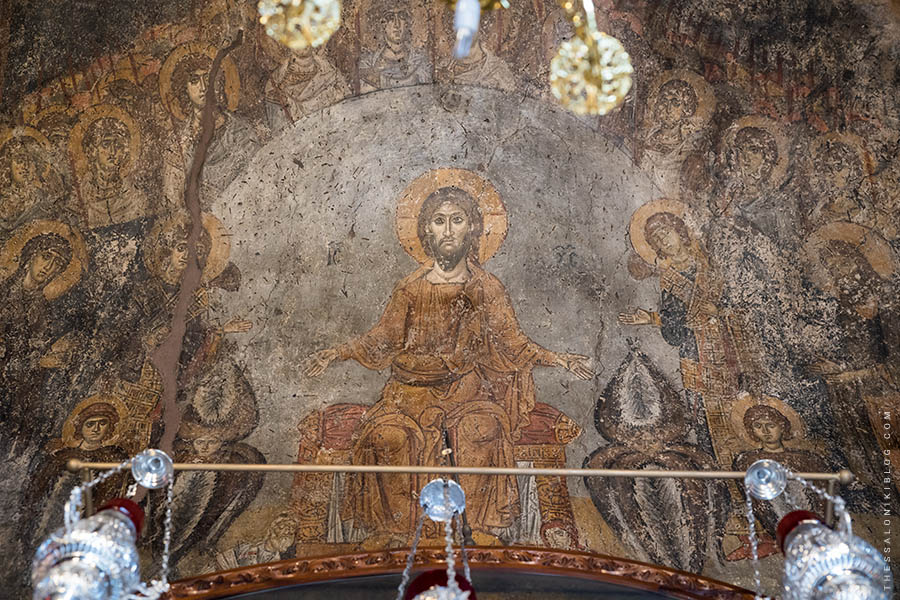
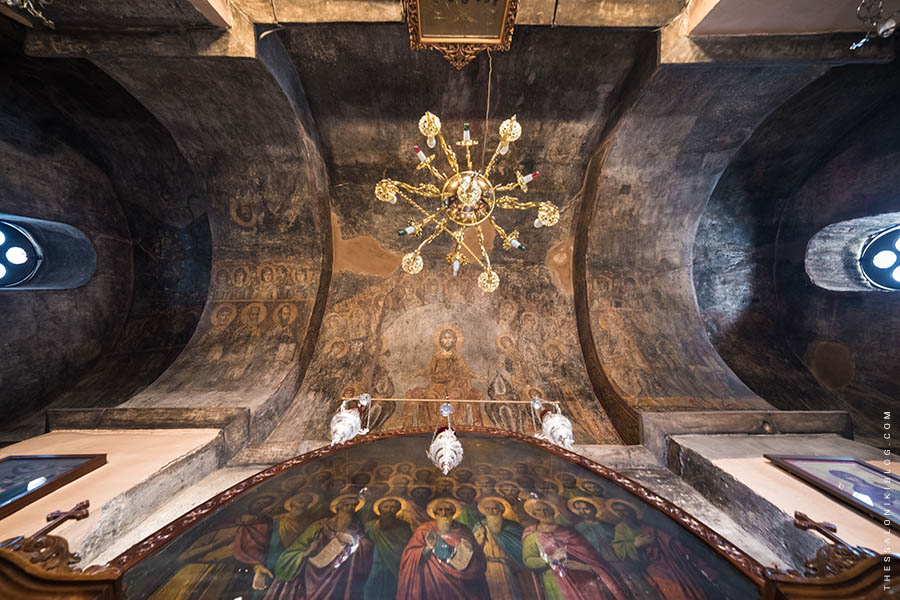
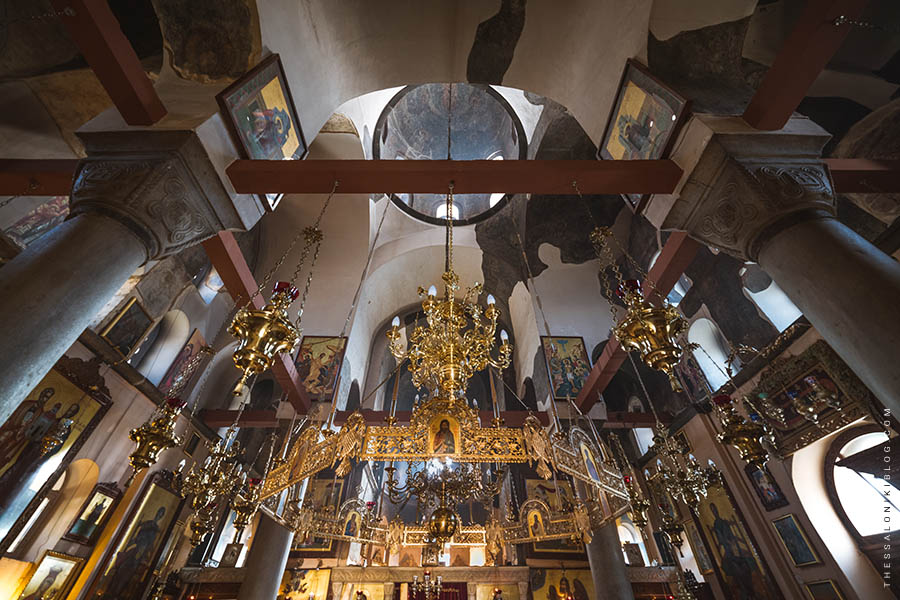
3) PANAGIA ACHEIROPOIETOS
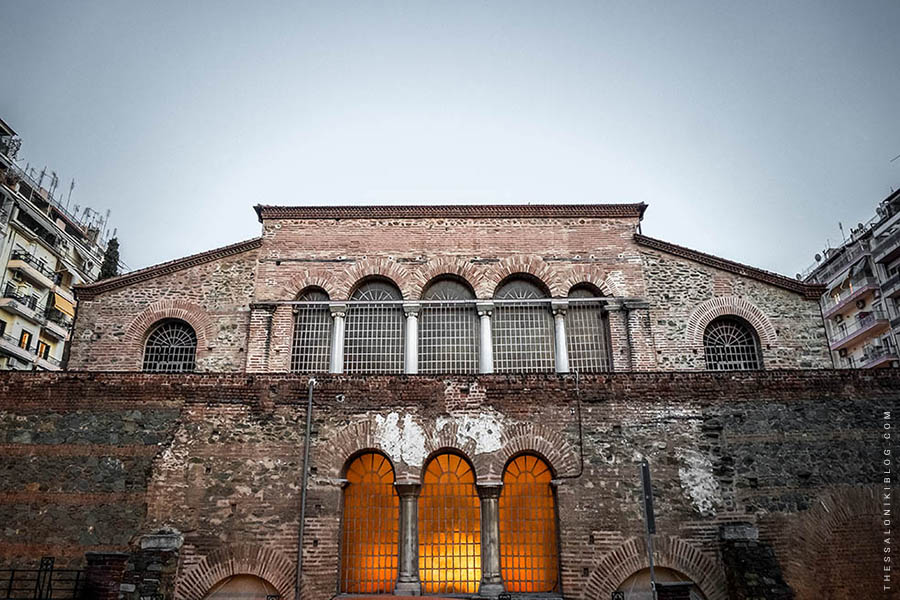
Address: 54 Agias Sofias Street (see on Google Maps)
Opening hours: Daily 07:30-12:00 and during the Vespers in the evening
Admission: Free entrance
Phone number: +30 231 027 2820
Address:
54 Agias Sofias Street (see on Google Maps)
Opening hours:
Daily 07:30-12:00 and during the Vespers in the evening
Admission:
Free entrance
Phone number:
+30 231 027 2820
The church of Panagia Acheiropoietos is a Paleochristian three-aisled basilica with a wooden roof. It was built between the years 450-475 AD, and since those ancient times it has kept its original form and architectural elements without any significant changes. Therefore, it stands out as one of the most representative and rare examples of architecture from the Paleochristian period. Its current name is a reference to a supposedly miraculous icon of Virgin Mary that was worshipped in the temple itself (“Panagia” is the most common name of the Virgin in Greek and “Acheiropoietos” means non-handmade). It was believed that the icon was created by Angels. Before the 14th century, the church was named Panagia Theotokos.
Similarly to the church of Agios Dimitrios, Acheiropoietos was built on the ruins of a Roman bath (floor mosaics of the bath have been discovered under the North aisle). The south side of the church was probably facing the main road of the city, the Roman “Via Regia” or, as it was called later by the Byzantines, the “Leophoros” (now Egnatias Street). Today, at the South entrance there is a porch and a restored annex that was probably used as a baptistery. At the East end of the North aisle, there is the chapel of Agia Eirini, dated from the Middle Byzantine Period.
How to get there:
From Panagia Chalkeon, walk east for 400m on Egnatias Street. At the junction with Agias Sofias Street turn left and walk north for another 80m. Independently of our recommended itinerary you can get there easily by foot, from the center of the city, or by any bus that passes from the adjacent “Agia Sofia” bus-stop on Egnatias Street.
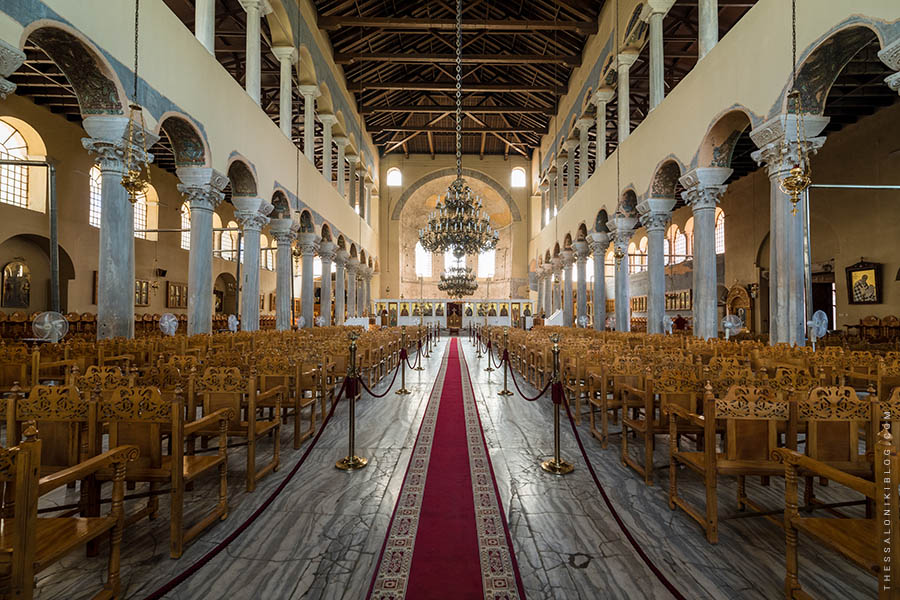
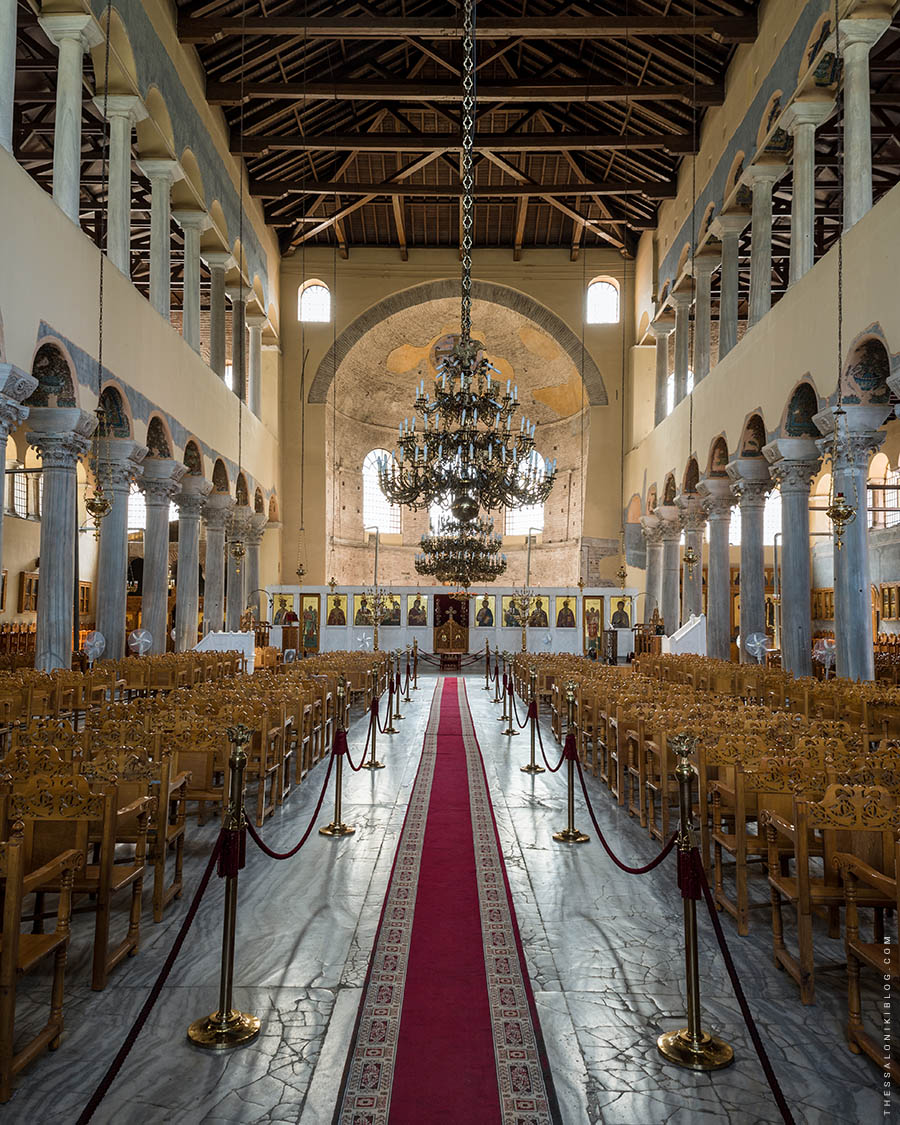
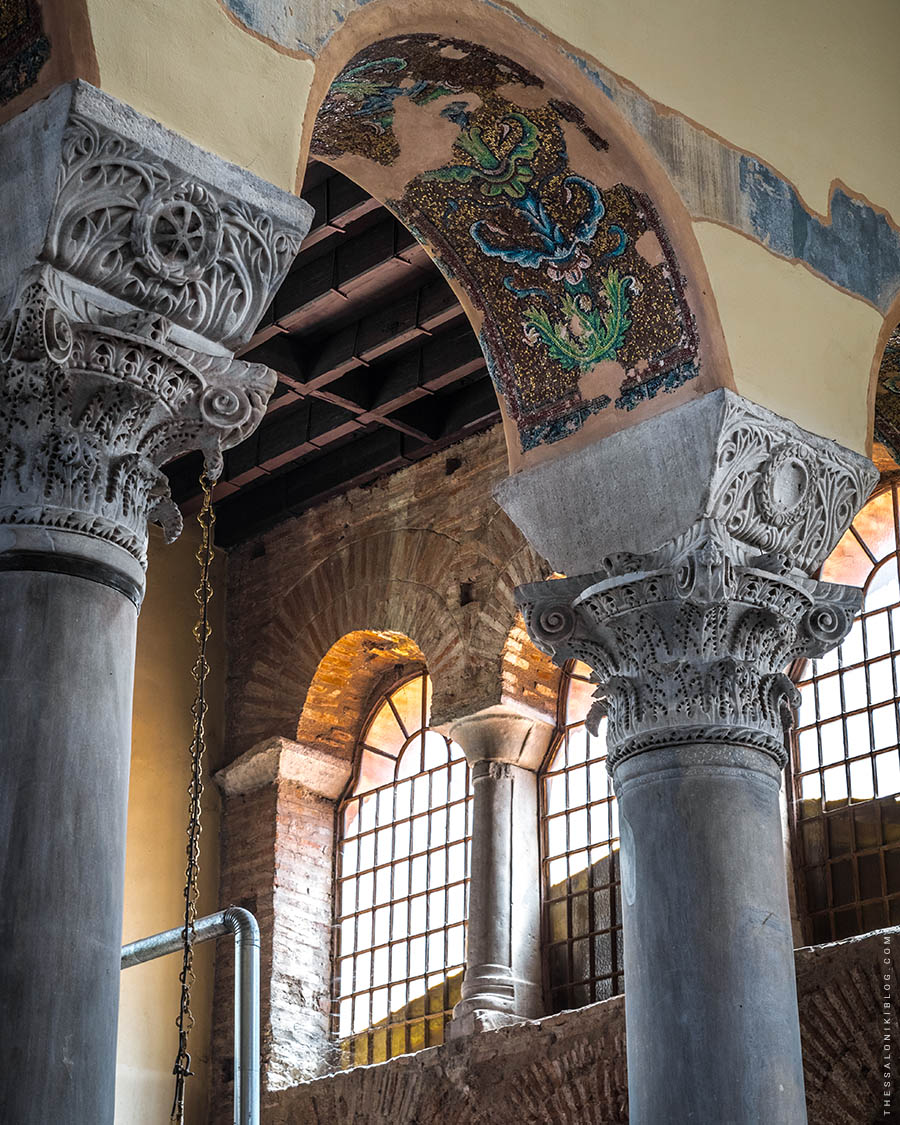
4) AGIA SOFIA (CHURCH OF GOD'S WISDOM)
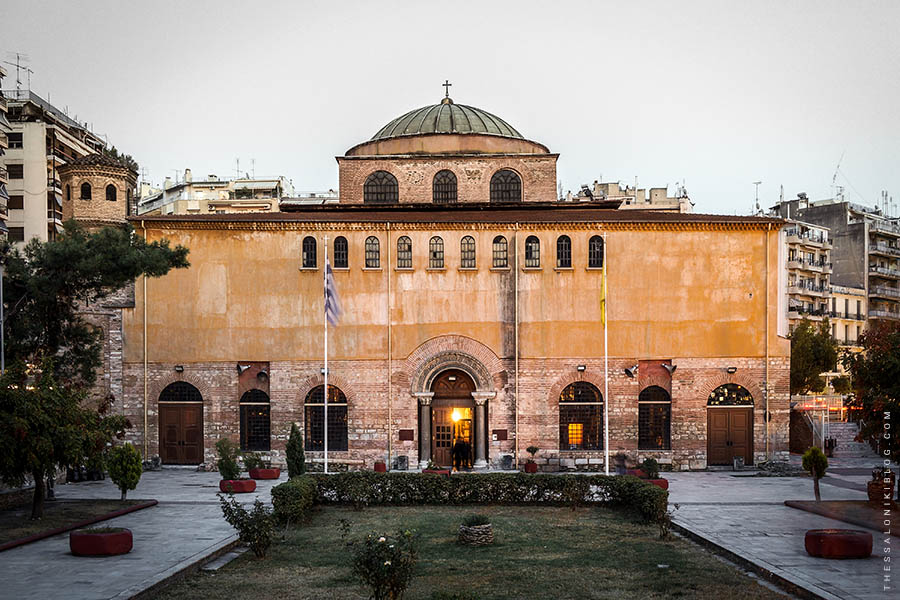
Address: Agias Sofias Square (see on Google Maps)
Opening hours: Daily 08:00-20:00
Admission: Free entrance
Phone number: +30 231 027 0253
Address:
Agias Sofias Square (see on Google Maps)
Opening hours:
Daily 08:00-20:00
Admission:
Free entrance
Phone number:
+30 231 027 0253
The church of Agia Sofia (dedicated to the Wisdom of God) is one of the oldest, largest and most important Byzantine churches of Thessaloniki. Likewise Agios Dimitrios and Panagia Acheiropoietos, it was built on a site where a Roman bath used to be. Its architecture follows the transitional “cross-in-square” type, with an ambulatory and a dome, resulting from the transformation of the “basilica with a dome” type. It was built in the late 7th or the 8th century AD, in replacement of an older Paleochristian five-aisled basilica of the 5th century, that was probably destroyed by an earthquake between 620-630 AD.
Until today, the temple holds the honorary title of the city’s Cathedral, like it used to be from the middle of the 13th century and until its conversion into a mosque by the Ottomans in 1523/24. The tower at the north-west corner of the building, which contains the internal stairs that lead to the galleries inside the temple, is a remaining Ottoman addition. The minaret that was added on the south-west corner has not been saved. On the west side there was also a porch that was demolished in the beginning of the 20th century.
The name, the typology, and the hierarchy of Agia Sofia as the city’s cathedral, are references to the brilliant temple of Agia Sofia (Hagia Sophia) in Constantinople. Its interior is decorated with beautiful mosaics that were created between the 8th and the 12th century and are considered great works of Byzantine Art. Because Iconoclasm was dominant when the temple was built, the first mosaics of the temple, dated in the 8th century, are depicting strictly decorative patterns while those created after Iconolatry had prevailed are iconic images depicting the Ascension of Jesus Christ (9th century) and Virgin Mary holding Jesus (11-12th century). The mosaic of the Ascension of Jesus Christ, decorating the dome of the temple, is considered a masterpiece of the Macedonian Period of the Byzantine Empire.
There are only a few Byzantine wall-paintings that have been saved. They were created in the 11th century and are located on the arches of the narthex’s windows. The rest of the decorative wall-paintings, that cover a large amount of the interior, were created while the monument was still a mosque and particularly after the temple was damaged by fire in 1890.
The fine ornate marble capitals of the north colonnade at the floor level (two of the “wind-swept acanthus” type and one of the “basket capital” type) were probably saved and reused from the 5th-century church that was destroyed on the site. The shapes of the capitals at the south colonnade and on the galleries have been reconstructed with plaster after the originals were damaged in the fire of 1890. At the exterior, the sculptural decoration of the temple is found at the columns of the windows at the north side and at the archways of the west and south entrances, each one consisting of two columns with capitals and an arched header.
How to get there:
From Panagia Acheiropoietos, walk south for approximately 250m on Agias Sofias Street until you reach the namesake square. Independently of our recommended itinerary, you can get there easily by foot, from the center of the city, or by any bus that passes from the adjacent “Agia Sofia” bus-stops on Egnatias Street or Tsimiski Street.
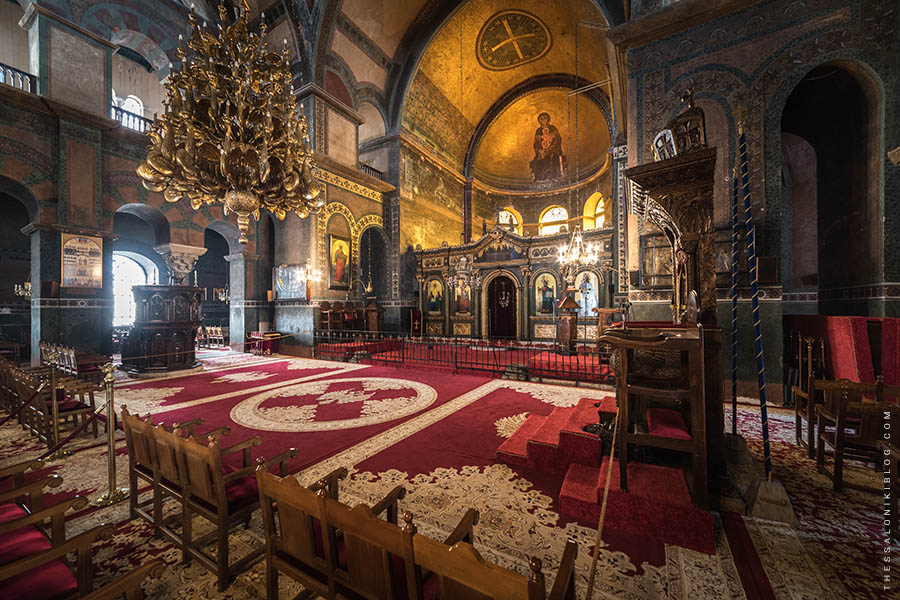
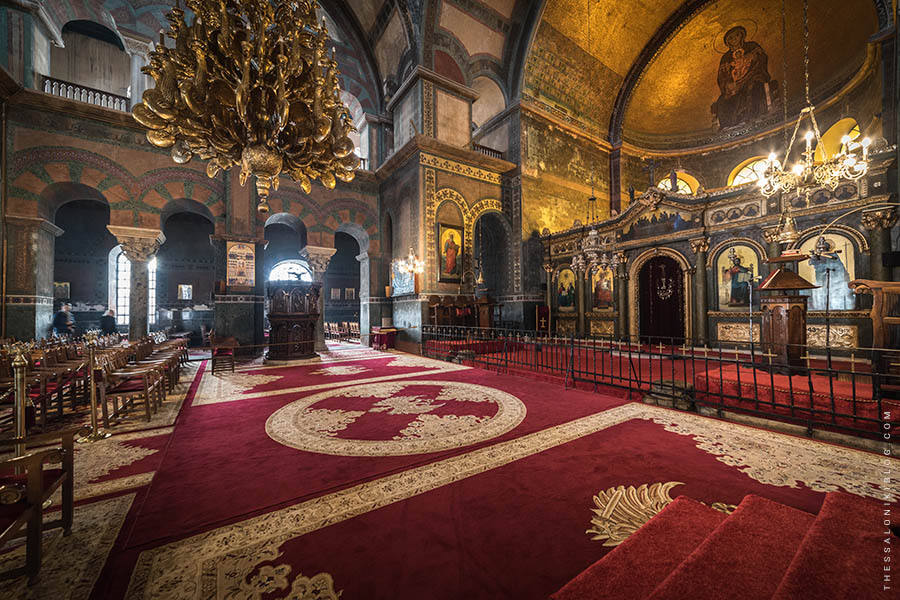
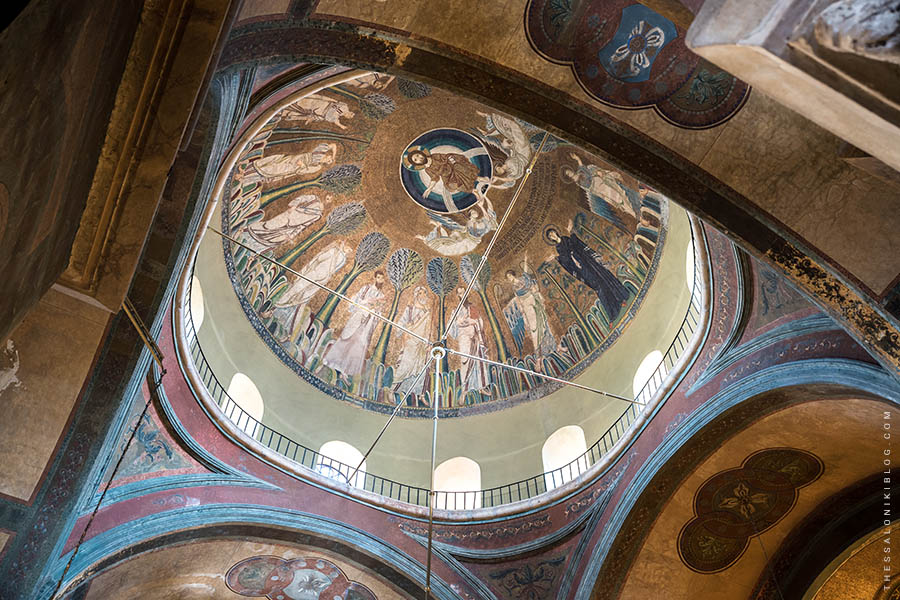
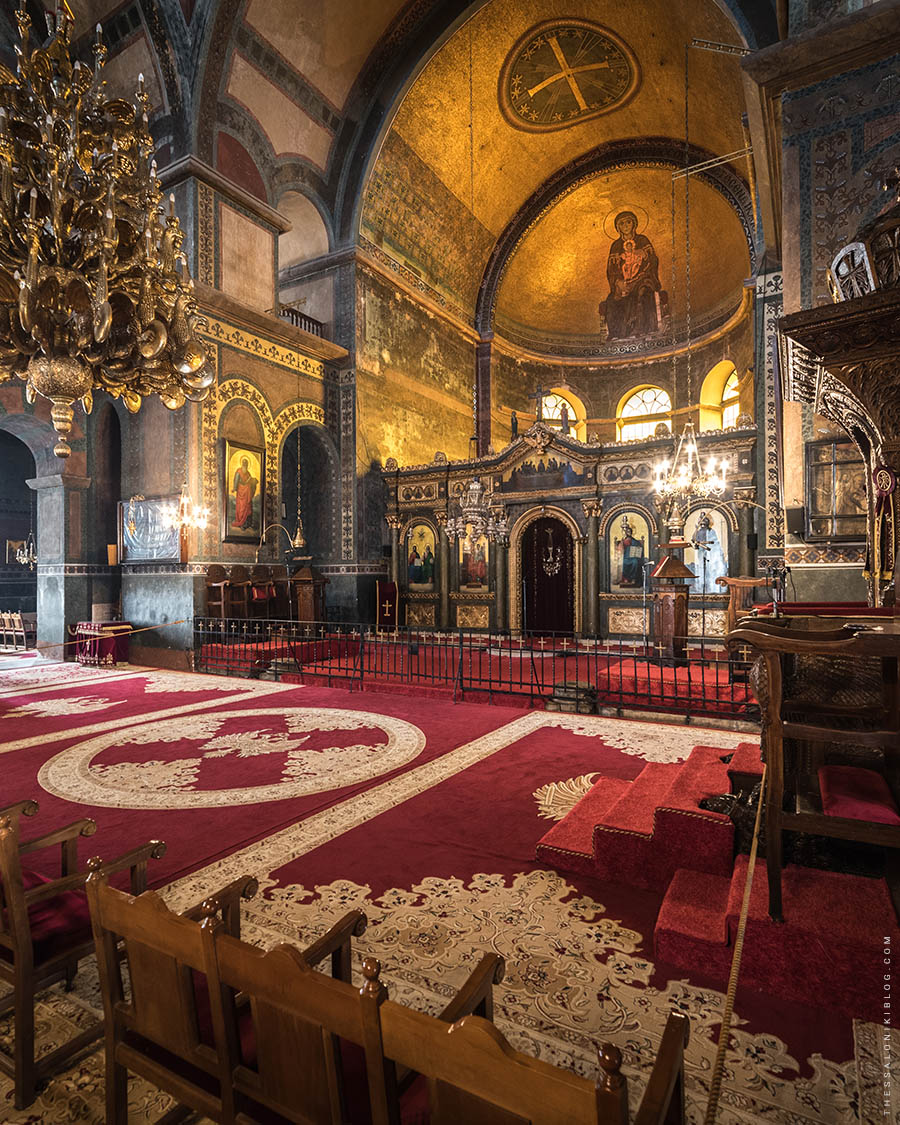
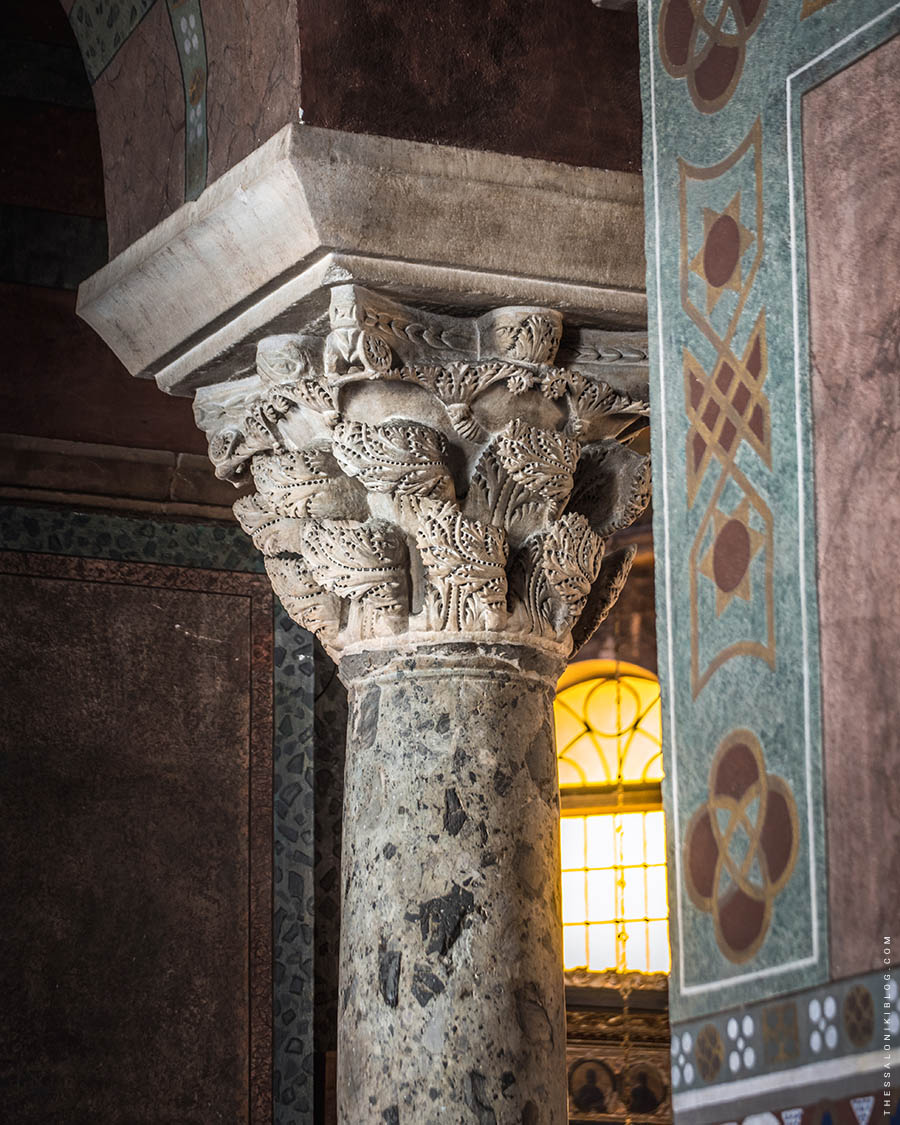

5) THE MOSAICS OF THE ROTUNDA
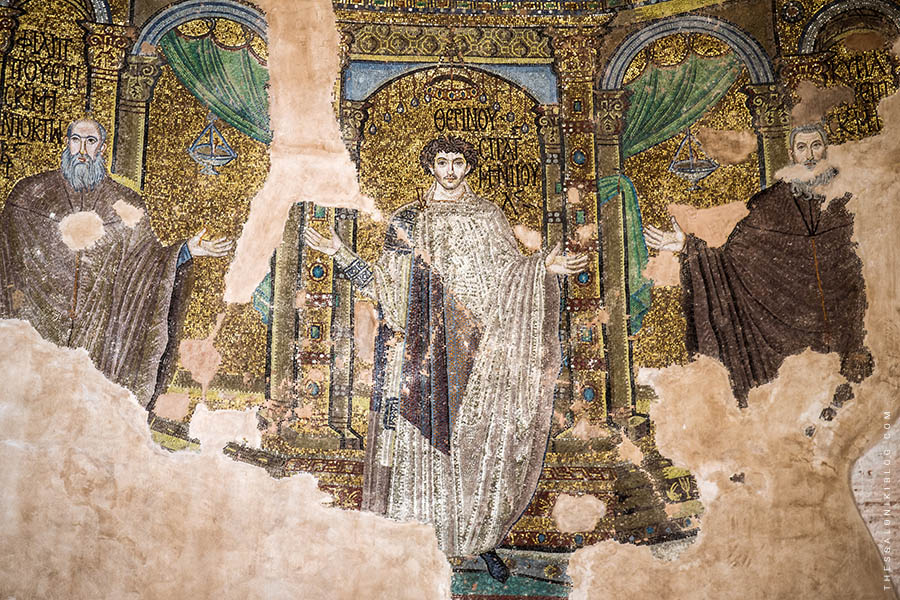
Address: Agiou Georgiou Square (see on Google Maps)
Opening hours:
Wednesday to Monday: 08:30-15:30
Tuesdays: Closed
Admission: 3€
Phone number: +30 231 020 4868, +30 231 020 9545
Address:
Agiou Georgiou Square (see on Google Maps)
Opening hours:
Wednesday to Monday: 08:30-15:30
Tuesdays: Closed
Admission:
3€
Phone number:
+30 231 020 4868, +30 231 020 9545
The Rotunda of Thessaloniki is a monumental Roman edifice that was built at the beginning of the 4th century AD. Despite it belongs to the Roman Period, it is listed in UNESCO’s “Paleochristian and Byzantine Monuments of Thessaloniki” because of its importance to the Byzantine World after it was modified and converted into a Christian church and most of all because of its brilliant Paleochristian mosaics.
The construction of the Rotunda was arguably orderer by Emperor Galerius during the Tetrarchy of the Roman Empire. After his death, in 311 AD, the project was continued by Constantine the Great. Its initial purpose was to be either a pagan temple or a mausoleum. The building is shaped in a cylindrical form with a dome and it resembles the Pantheon of Rome. At the center of the dome, there even used to be an oculus likewise the one on the Pantheon. The oculus was covered after the Rotunda was converted into a church.
The center of the Rotunda was on the axis of the Processional Way, a monumental road which was connecting the south entrance of the building with the Triumphal Arch and the Imperial Palace of Galerius. Its diameter is 24.50m and its height is 29.80m. The thickness of its cylindrical wall reaches the remarkable width of 6.30m. In the interior of the building, the cylindrical wall is shaped with eight barrel-vault bays. Above them, there are eight large arched windows and eight smaller ones at the base of the dome. The walls of the Rotunda were constructed with rubblework and bricks, while the arches, the vaults, and the great dome were constructed with bricks only (unlike the Pantheon’s dome which was constructed entirely with concrete).
Rotunda was converted into a Christian church in the late 4th century (it was probably ordered by Theodosius between 379-395). The modifications that were made to the building at that time included the addition of a sanctuary at the east side (that demanded the demolition of the east bay and the wall above it) and an 8-meter wide external closed ambulatory (which was communicating with the interior by openings made in the bays). There was also constructed a new entrance with a narthex at the west side, and a propylon with two chapels at the south entrance. Besides the sanctuary, none of the above additions have been saved.
The modifications for the addition of the sanctuary, however, affected negatively the durability of the building. During the big earthquakes that struck the city in the early 7th century, part of the sanctuary, the cylindrical wall, and the dome at the east side collapsed causing also the loss of the mosaics at that area. The building was repaired and reinforced with two external buttresses.
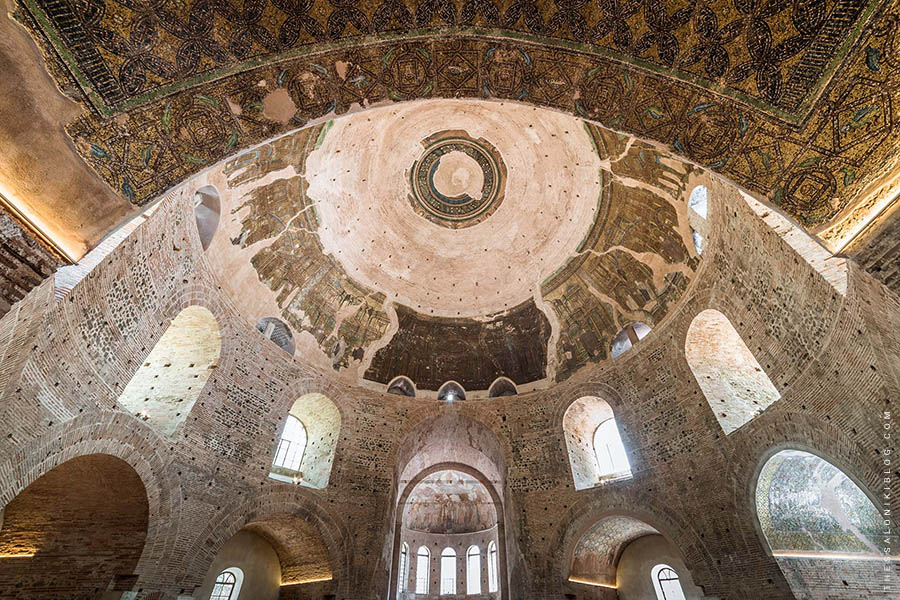
The wonderful mosaics of the Rotunda on the dome, on the barrel vaults of the bays, and on the small arched openings at the base of the dome, were created during the conversion of the building into a church. They are considered some of the greatest and oldest mural mosaics that have been preserved. The mosaics on the dome are divided into three zones. Along the lower one, which is the most well-preserved, fifteen (15) figures praying with their hands lifted, are depicted in front or several Greco-Roman architectural compositions. Along the middle zone, which is almost entirely destroyed, there were probably illustrations of the Apostles or Angels, while in the last zone, at the top of the dome (where the oculus used to be), there was the scene of a Theophany. Of the latter scene only the wings and three of the four heads of Angels are saved together with decorative floral motifs arranged in circles.
The rest of the mosaics that have been saved are located on three of the bays’ vaults and four of the arched openings. These mosaics are strictly decorative with geometrical patterns combined with flowers, fruits, leaves, and birds. The wall-painting with the Ascension of Christ on the sanctuary apse was created in the 9th century, replacing probably an older mosaic that was destroyed. On the east side of the dome, there is the wall-painting of the Italian artist Rossi, which was created in 1889. It is a rendition of the missing section of the mosaic that was lost when part of the dome collapsed in the 7th century.
The Rotunda functioned as a Christian church for almost 1,200 years until it was converted into a mosque in 1590/91. Earlier, following the conversion of Thessaloniki’s Agia Sofia into a mosque in 1523/24, Rotunda had taken the place of the latter as the Cathedral of the city. After Rotunda’s conversion, a minaret was built southwest of the building (it is the only minaret of Thessaloniki that is preserved). Other Ottoman additions that survived are the porches and the marble decorations at the south and west entrances and a fountain at the west side. East of the sanctuary, there is also an Ottoman burial area.
When the Ottoman Rule in Thessaloniki ended in 1912, the Rotunda functioned again as a Christian church for only two years. At that time it was named Agios Georgios (Saint George), referring to a adjacent small church with the same name. Today Rotunda is open to the public as a historical monument and a museum, while it is being used as a church only for a few occasions throughout the year.
How to get there:
From the back side (east view) of Agia Sofia, walk east for 320m on Alexandrou Svolou Street. At the junction with Dimitriou Gounari pedestrian street, turn left and you will see the Rotunda at 300m in front you across Egnatias Street. Its entrance is accessed by Agiou Georgiou Street, on the west side of the monument. Independently of our recommended itinerary, you can get there easily by foot, from the center of the city, or by any bus that passes from the adjacent “Iasonidou” or “Kamara” bus-stops on Egnatias Street, or “Panepistimio” bus-stop on Ethnikis Aminis Street.
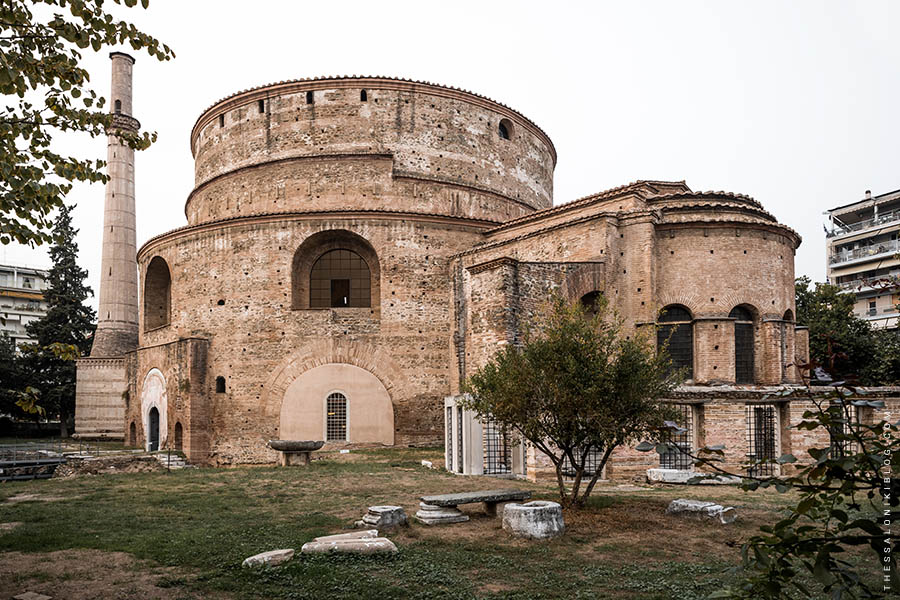
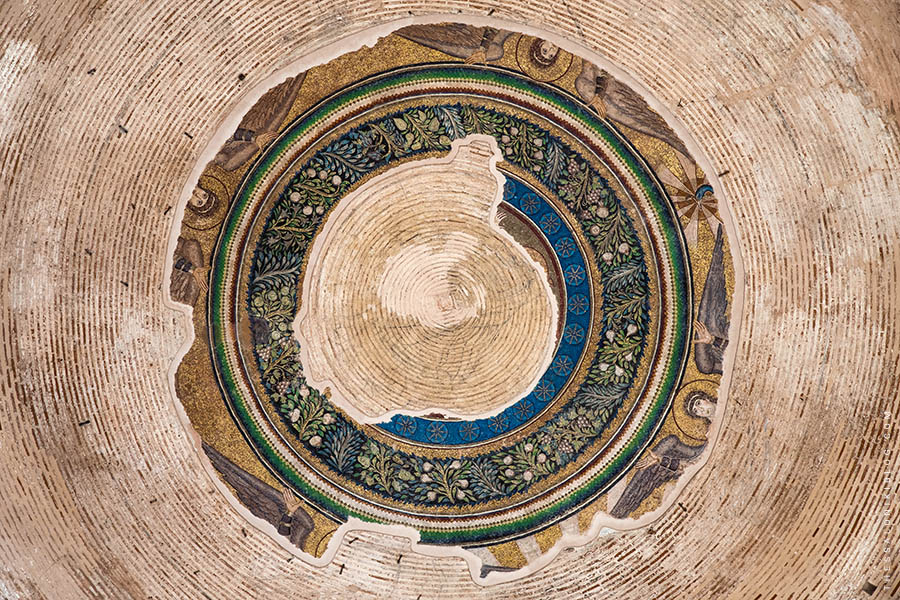
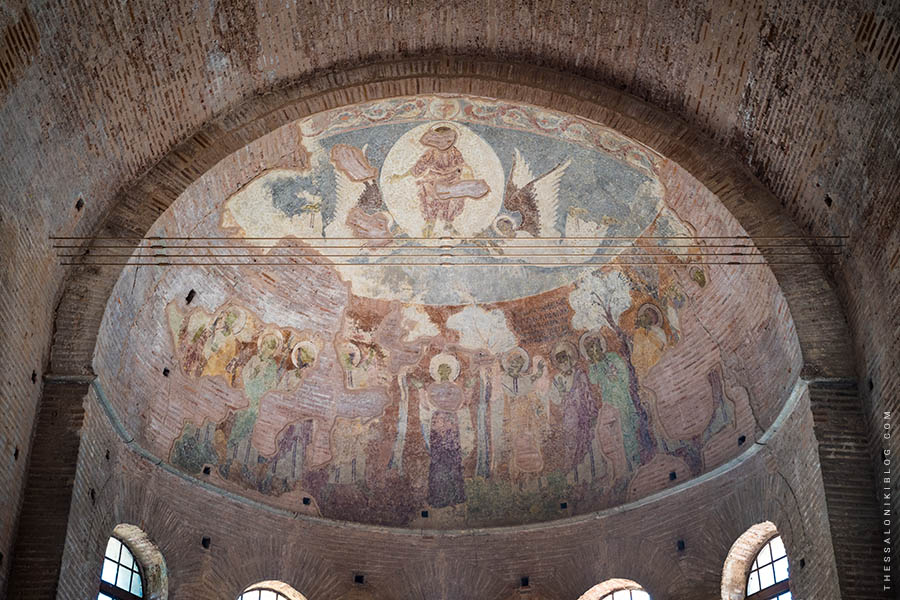
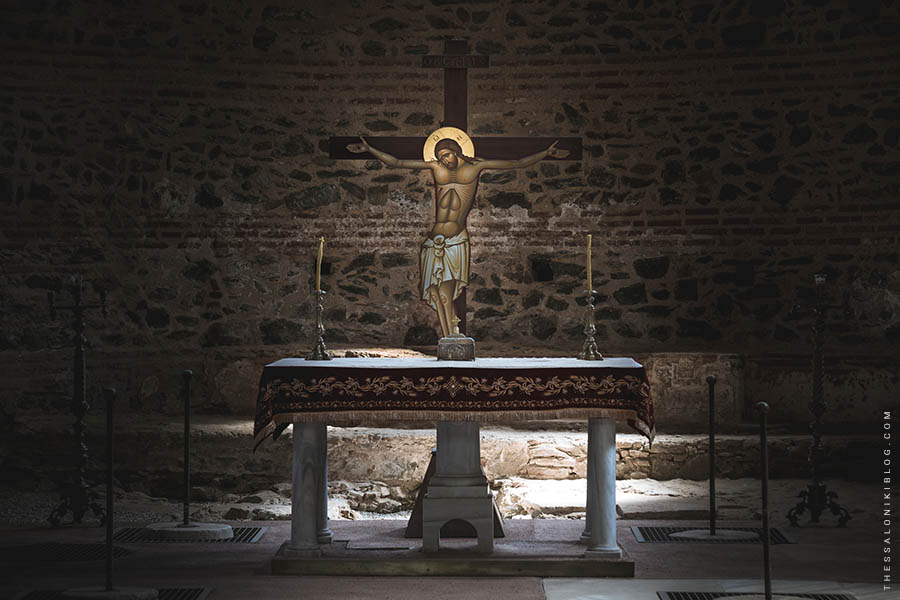
6) CHURCH OF AGIOS PANTELEIMON (SAINT PANTALEON)
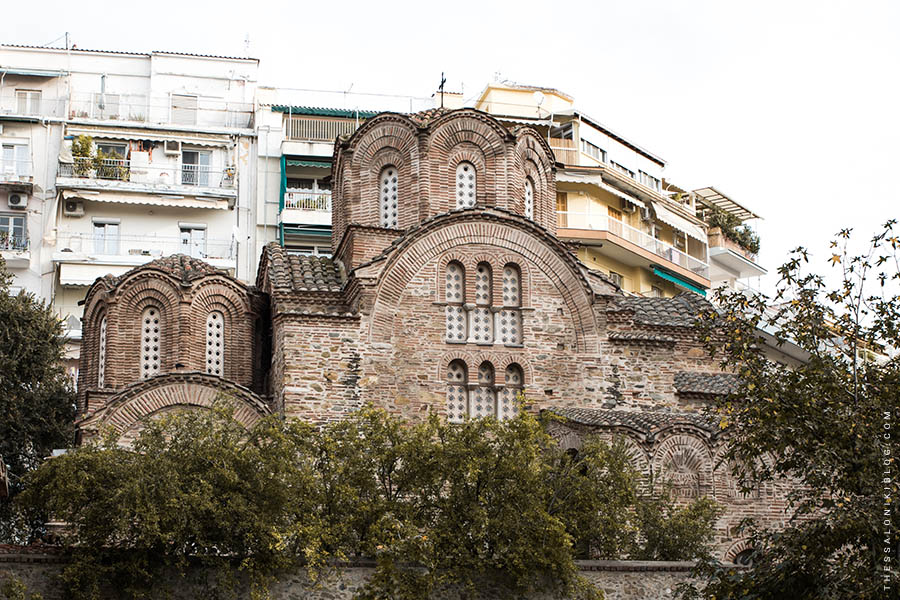
Address: Junction of Iasonidou and Arrianou Streets (see on Google Maps)
Opening hours:
Monday to Thursday: 08:00-13:00 and 17:30-19:00
Friday: 08:30-13:00 and 19:00-22:45 (church Service at 20:00)
Saturday: 08:00-13:00
Sunday: 07:00-12:00 (church Service at 07:30)
Admission: Free entrance
Phone number: +30 231 020 4150
Address:
Junction of Iasonidou and Arrianou Streets
(see on Google Maps)
Opening hours:
Monday to Thursday: 08:00-13:00 and 17:30-19:00
Friday: 08:30-13:00 and 19:00-22:45 (church Service at 20:00)
Saturday: 08:00-13:00
Sunday: 07:00-12:00 (church Service at 07:30)
Admission:
Free entrance
Phone number:
+30 231 020 4150
Agios Panteleimon is a Byzantine church of the Paleologan Period that was built between the late 13th and the early 14th century. Its architecture follows the complex tetrastyle cross-in-square type, with a dome, a narthex, an ambulatory, and two chapels at the east side, left and right of the sanctuary. Besides the main dome, smaller domes were built over the narthex and the ambulatory. It was probably the Katholikon (the “main church”) of a Byzantine monastery. The few Byzantine wall-paintings that have been saved were created during the same period when the church was built and belong to the Paleologan Art. The columns and the capitals that support the main dome have been taken from older buildings.
The temple was converted into a mosque in the 16th century with the name Ishakiye Camii (the “Mosque of Isaac”). It was named Agios Panteleimon when the temple was restored to the Christian worship after 1912. During its conversion into a mosque, a marble fountain was built in the courtyard and also a minaret that hasn’t been saved. At the beginning of the 20th century, during modifications that were made by the Ottomans, the ambulatory and its domes were demolished. However, the chapels were saved (although completely open at their west side). The wall paintings in the narthex also belong to that period (20th century).
How to get there:
From the Rotunda walk west for 100m on Patriarchou Ioakim Street until you reach Iasonidou Street. Independently of our recommended itinerary, you can get there easily by foot, from the center of the city, or by any bus that passes from the adjacent “Iasonidou” bus-stop on Egnatias Street.
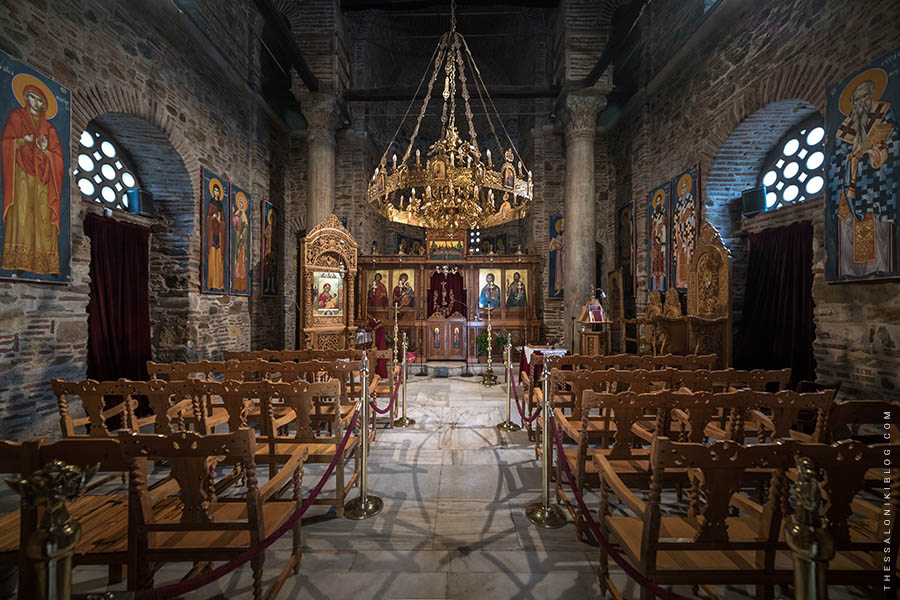
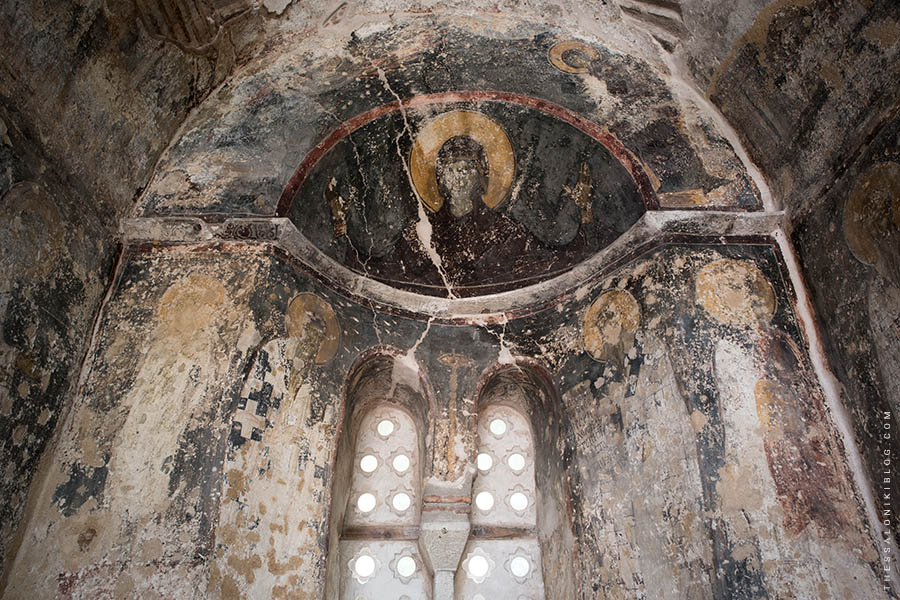
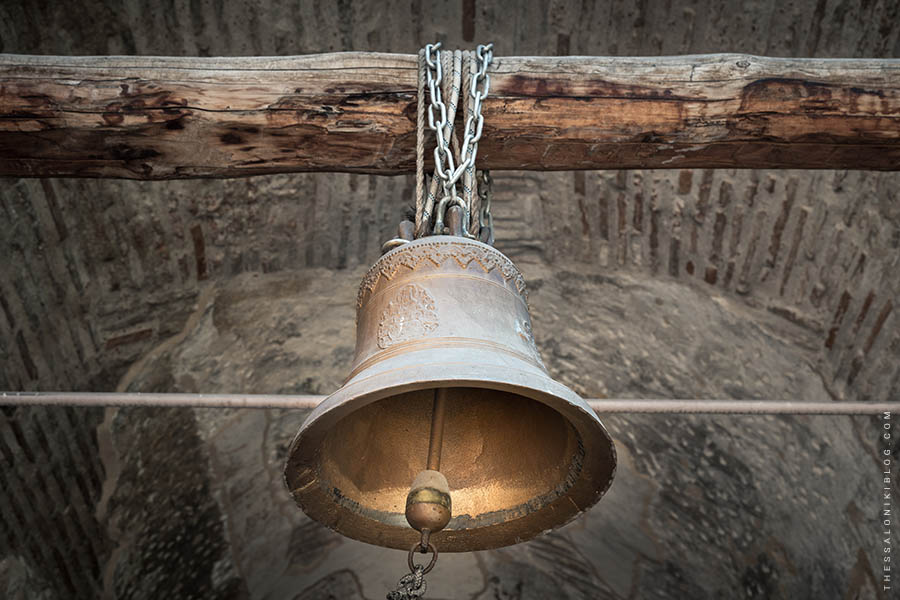
7) CHURCH OF THE SAVIOR
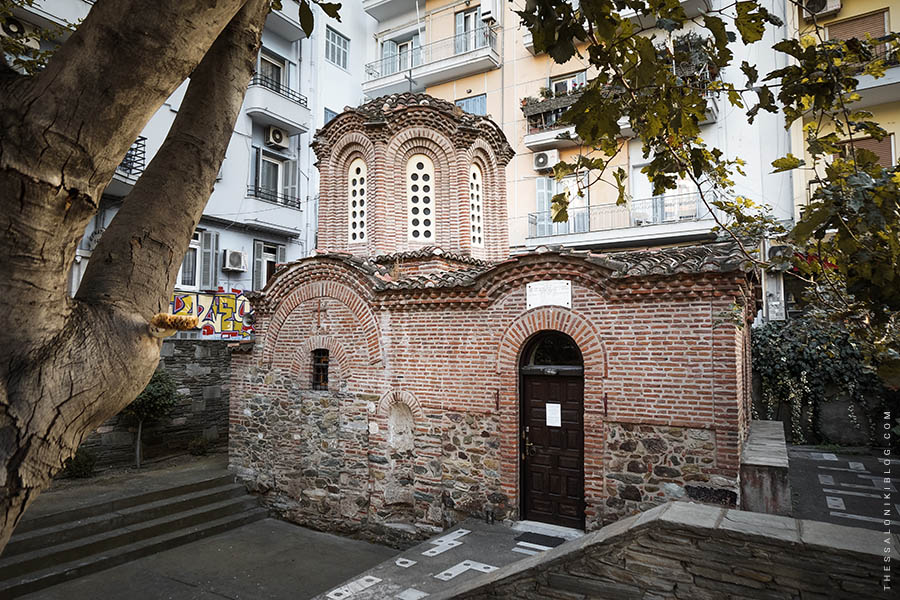
Address: 140 Egnatias Street (see on Google Maps)
Opening hours:
Monday to Saturday: 09:00-13:00 and 15:00-17:00
Church Service on Thursdays (07:30-09:00)
Sundays: Closed
Admission: Free entrance
Phone number: +30 231 022 3009
Address:
140 Egnatias Street (see on Google Maps)
Opening hours:
Monday to Saturday: 09:00-13:00 and 15:00-17:00
Church Service on Thursdays (07:30-09:00)
Sundays: Closed
Admission:
Free entrance
Phone number:
+30 231 022 3009
The Church of the Savior (or the “Transfiguration of the Savior”), initially dedicated to the Virgin, is a 14th century Byzantine small temple, built in the rare “inscribed tetraconch” type. It was probably used as the burial chapel of an old monastery. During its restoration, following the earthquake of 1978, several graves were discovered under the floor and around the temple. The wall-painting on its dome, dated from the same period that the church was built (1350-1370), was also discovered during its restoration and belong to the Paleologan Art.
The narthex at the west side of the Chapel was constructed in 1936 replacing an older structure. The church was one of the few that was not converted into a mosque during the Ottoman Period of the city, most likely due to its small size and because it was part of a residence in the area that used to be the Christian neighborhood of Panagouda.
How to get there:
From the church of Agios Panteleimon, walk down (south-east) on Iasonidou Street east for 100m until the junction with Egnatias Street. The Church of the Savior is located just across the street. Independently of our recommended itinerary, you can get there easily by foot, from the center of the city, or by any bus that passes from the adjacent “Iasonidou” bus-stop on Egnatias Street.
